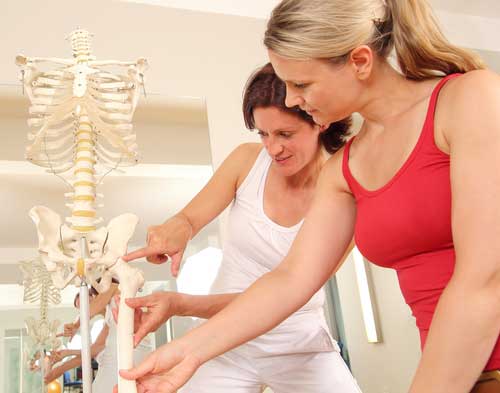It’s no secret that regular exercise helps control body fat and trim fat from those areas, like your tummy, where you don’t want it. Here’s more good news. Regular workouts may alter fat distribution somewhere else – deep inside your bones.
Bone fat? Yes, there’s fat inside your bones too, in the portion called the bone marrow. You don’t start out with fat in your bones. Babies are born with almost no bone fat, but, as you age, your bone marrow fills up with fat. By the time you’re a senior, your bone marrow as turned mostly into fat. What’s interesting is people with osteoporosis have more fat in their bone marrow than people who don’t. No one knows why bone fills with fat with age and why people with osteoporosis have more fatty tissue. Because fat build-up in the bone marrow is more common in people with unhealthy bones, the build-up of fat appears to be a negative in terms of bone health.
A new study carried out by researchers at the University of North Carolina School of Medicine made a surprising discovery about bone fat. Regular exercise may help prevent the build-up of fat inside bones. In this landmark study, mice that ate a high-fat diet experienced a marked increase in bone fat – BUT when mice continued to eat a high-fat diet and ran voluntarily on an exercise wheel, the quantity of fat in their bones decreased. In this study, exercise seemed to protect against the accumulation of fat inside bones. Research already shows high-impact exercise has a positive influence on bone health. Could this be one of the reasons why?
Influencing Stem Cells for Better Bone Health
How might exercise influence the build-up of fat inside the bone marrow? Inside your bone marrow are stem cells. Bone stem cells have the capacity to turn into bone cells, which is what you want, or fat cells, which you don’t, depending upon genetics and signals they receive from their surroundings. In one study, researchers added vitamin D to stems cells in culture. Voila! The stem cells turned into bone cells. When they instead added hormones called glucocorticoids, linked with lower bone density, stem cells were transformed into fat cells.
Stem cells have the capacity to go down either pathway and factors like nutrition and exercise likely influence which way they go. It’s possible that a hormone or chemical produced in response to exercise gives stem cells the nudge they need to make bone instead of fat.
Exercise for Bone Health
It’s clear that exercise influences bone health. This latest study may have identified another reason why. High-impact exercise, exercises where both feet leave the floor at the same time, places enough stress on bones to encourage them to adapt and grow. Examples are exercises like plyometrics that involve jumping and other jumping exercises like jumping jacks and jump rope. Running and some forms of step training are also high impact.
Less appreciated is the fact that resistance training also boosts bone health, as long as you do it with enough intensity. If you contract a muscle against heavy resistance, the muscle pulls on the tendon and the tendon pulls on the bone. The stress on the bone causes cells called osteoblasts to produce more collagen. The collagen is then mineralized and hardened to become bone. Just as your muscles adapt and grow in response to resistance training, so do your bones.
The load you place on your muscles has to be large enough to pull on the bone and bend it slightly. Training with lighter weight and higher reps won’t place enough stress on the bone to promote growth. You need to subject your bones to a minimal degree of stress, called the minimal essential strain, to get your bones to lay down new collagen. So, think heavy, 80% or more of your one-rep max. Just as you have to increase the load you place on your muscles over time, you need to do the same to stimulate your bones. You also have to train consistently, at least two times a week to maximize bone growth.
Why Should You Be Concerned about Bone Health?
Just as you begin to lose muscle mass after the age of 30, you start to lose bone around this time too. Bone loss accelerates after menopause, partially due to a drop in estrogen. It’s important to get enough calcium and vitamin D in your diet to help preserve the health of your bones. Risk factors for osteoporosis include being female, post-menopausal status, eating a diet low in fruits and vegetables, being sedentary, smoking, excessive use of alcohol, family history and being underweight or having small bones. You may not have control over your sex, menopausal status, family history or the size of your bones but you can improve your bone health by doing a balanced workout that includes high-impact exercise and resistance training.
The Bottom Line?
Don’t let the inside of your bones turn to fat. Keep working out and getting enough vitamin D and calcium. Keep your bones healthy as you age!
References:
New York Times. “With Osteoporosis, Fat Seems to Fill Old Bones”
Science Daily. “Fat of the Bone: Exercise, Diabetes Affect Amount of Fat Inside Bones”
National Osteoporosis Foundation. “Exercise for Strong Bones”
The Sports Journal. “Training to Improve Bone Density in Adults: A Review and Recommendation”
Natural News. “Bone Density Sharply Enhanced By Weight Training, Even in the Elderly”
National Osteoporosis Foundation.
Related Articles By Cathe:
Are Certain Types of Exercise Bad for Bone Health?
Dieting to Lose Weight May Endanger Bone Health
Is It Time to Ditch the Calcium Supplements?
Is Resistance Training Better Than High-Impact Aerobics for Bone Health?
The 3 Best Types of Exercise for Bone Density and Health


